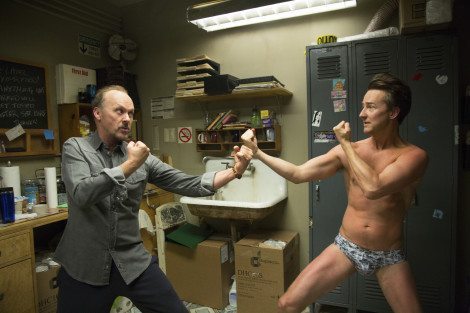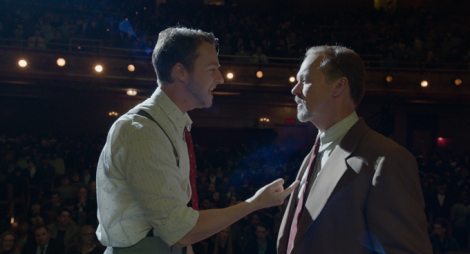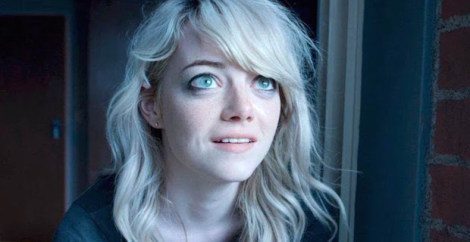Birdman or (The Unexpected Virtue of Ignorance) is a spectacular film in every sense of the word, and one of its most obvious and unique spectacles is that the film appears as though they shot the entire thing in one continuous take. Those few reviewers who gave the film a negative review pointed to this choice as one of the indicators that Birdman is pretentious and bloated- it’s a fun gimmick, they say, but is there any real point to it? I have to wonder if these critics realize the irony of this statement, as Birdman deliberately mocks critics who decide their opinion on films before even seeing them, which is almost exactly what they’re doing. If they’d spent even a moment actually thinking about the purpose behind this choice, they’d realize that not only did director Alejandro Gonzalez Inarritu have a reason, but he had a whole bunch.
We’ll start by addressing the one time this has been done before: in the Alfred Hitchcock classic Rope back in 1948. Rope took place in real time, meaning the 80 minutes for us as an audience is also 80 continuous minutes in the lives of the characters, so the one-take strategy makes a decent amount of sense, as there’s no need to ever cut to skip ahead in time. But Rope was in real time before Hitchcock ever adapted it, as the original 1929 play also operated in such a way given that it had no act breaks. This might suggest the reason Inarritu settled on the one-take strategy in the first place: watching the film all in one take feels a lot like watching a play, where there are no cuts, and Birdman primarily concerns the process of producing a play.

There are also thematic reason why Birdman appears all in one take. In the film, Riggan attempts to adapt Raymond Carver’s story “What We Talk About When We Talk About Love” to the stage, and by contrast, the short story is full of cuts. Normally writers, including Carver, will break up the segments of their story with extra space only to skip ahead in time or change locations, but in “What We Talk About,” these breaks come out of nowhere, often in the middle of a conversation. “What We Talk About” seems like a strange choice for Riggan’s adaptation for a lot more reasons too – the story’s barely long enough to support even a one-act play, meaning he would have to add tons of extra content (both the dream sequence and motel scene in the film weren’t in the original story). And for that matter, Riggan’s character Nick barely speaks in the original story. The monologue that appears in Birdman wasn’t part of Carver’s version; instead, Nick has only a handful of short lines, otherwise only acting as the POV while Mel (Edward Norton’s character in the film) rambles on for pages and pages. Weird choice of story for Riggan to make his star turn. All this is to ask, why would Inarritu choose a story that makes so little sense to adapt?

Well, on one level, it simply makes sense from a character level that Riggan would choose something so unproduceable. If he’s attempting to make something truly sophisticated and respected, you’d be hard-pressed to find a writer more intelligent, critically acclaimed and arguably pretentious than Carver. But you’ll also notice that “What We Talk About” almost acts as a thematic companion to Birdman. The characters in Carver’s story discuss a deeply abusive relationship involving stalking, threats of murder and multiple attempts at suicide; later, Mel recalls an old couple in a terrible car accident. The couples in the conversation don’t seem too happy either – Mel and his wife Terri constantly bicker and correct each other’s behavior, and the best that Nick can say of his wife Laura is “She’s easy to be with.”
Birdman also focuses on love (notice how, when the title fades out during the opening credits, the last remaining letters spell “amor?”), but the relationships in it are no better off. Riggan’s divorced, he and his girlfriend don’t seem particularly close, and his daughter hates him. Mike and Lindsay can’t seem to maintain even a solid sexual partnership either, let alone a romantic one. Both the film and the story pose the same question: does all this really count as love? The difference comes in the answer. In “What We Talk About,” it’s hard to imagine either marriage will continue particularly happily, and the stories they tell all have sad endings as well. But in Birdman, everything actually turns out for the best. Riggan and his ex-wife still love each other in their own way; his daughter grows to respect him; Mike finds a much happier and more compatible partner in Sam; Riggan even fixes his relationship with his audience. So doesn’t it make sense that the two works would have opposite structures as well? Doesn’t it make thematic sense that the story about doomed relationships would be full of breaks, whereas the hopeful story is all tied together?
And while we’re at it, let’s go back to that ending, because there’s one more big way that the one-take editing style works in the film’s favor. Birdman is mostly rather easy to believe (depending on your tolerance for extended fantasy sequences), but the ending definitely stretches that. Do we buy that the critic has changed her entire view on Riggan and his play, even when she defended her opinion so absurdly stubbornly before? What exactly has changed Sam’s opinion of her father all of a sudden? And what are we to make of the ending, in which Riggan apparently actually has super powers now?

Could the otherwise brilliant filmmakers really have overlooked all these inconsistencies? Or did they put them in intentionally – because Riggan succeeded in committing suicide and this is his post-mortal fantasy? I know, it’s a bit of a leap, but it simply doesn’t make sense otherwise. And what’s the only point in the entire movie where the shot cuts, deliberately showing the change in location and time? Immediately before this final scene, right after Riggan shoots himself. You’d be hard-pressed to find a more deliberate indicator that the story has moved into a different realm. But it only works because of the choice for the film to appear as one continuous take otherwise.
There’s plenty more to say about Birdman as pretty much everything about it is excellent, from the acting to the script to the soundtrack. But if Birdman goes down in the literary canon, it’ll be because of its editing. Let’s all just try to remember why.
I think this is what really happens…..read this arcticle here…..explains everything, BRILLIANTLY…… Thankyou
http://lynncinnamon.com/2014/11/birdman-jazz-drums-magical-realism-meaning-human-existence/
Birdman is nothing what you say….I am from Mexico, know the director and this is more of what he wanted us to get….Thanks….
http://lynncinnamon.com/2014/11/birdman-jazz-drums-magical-realism-meaning-human-existence/
Explains everything Brilliantly…..no doubts!!!!!!Ciao…